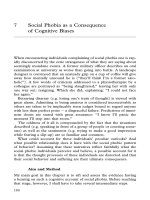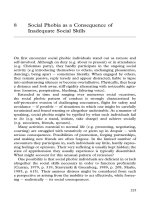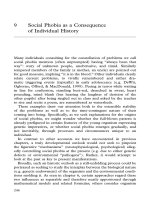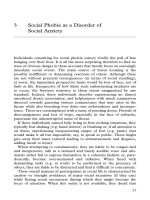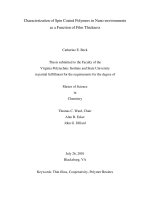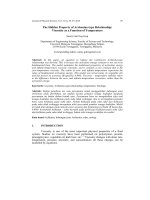Cardiovascular responses as a function of ethnicity, gender, 5HTTLPR genotype, dispositional anger and negative affect
Bạn đang xem bản rút gọn của tài liệu. Xem và tải ngay bản đầy đủ của tài liệu tại đây (705.9 KB, 143 trang )
CARDIOVASCULAR RESPONSES AS A FUNCTION OF
ETHNICITY, GENDER, 5HTTLPR GENOTYPE,
DISPOSITIONAL ANGER AND NEGATIVE AFFECT
MANRASNA KAUR THAKRAL
(B.A., MCGILL UNIVERSITY)
A THESIS SUBMITTED
FOR THE DEGREE OF MASTER OF SOCIAL SCIENCE
DEPARTMENT OF PSYCHOLOGY
NATIONAL UNIVERSITY OF SINGAPORE
2009
i
ACKNOWLEDGEMENTS
My sincere gratitude goes to Dr. George D. Bishop for his attention, guidance,
insight and support during this research and the preparation of this thesis. In addition,
I would like to extend a special thanks to Dr. Mike Cheung for his instruction and
assistance on the statistical procedures of this project. Many thanks also go to Francis
Ngau and the cardiovascular lab members for their efforts in the data collection phase
of this project, their assistance in the compilation of the master dataset and their
constructive comments throughout the process.
This research was funded by grant no. R-581-000-041-112 and R-581-000054-112 from the National University of Singapore Academic Research Fund with
George D. Bishop as principle investigator.
ii
TABLE OF CONTENTS
Page
SUMMARY……………………………...……………………….…………………..v
LIST OF TABLES …...……………………………………..………..………...…...vii
LIST OF FIGURES………………………………………………..……………...….ix
CHAPTER 1. INTRODUCTION…………………………………..................………1
1.1 Dispositional anger……..……………………..…………..........…...……8
1.2 Hypothesized mechanisms to CHD……….………..………………...….10
1.3 Dispositional anger and CVR……………......…………...……………...12
1.4 Negative affect in the daily environment….…...………………….……..17
1.5 The serotonin transporter gene polymorphism (5HTTLPR)………….…19
1.5.1 5HTTLPR genotype and CVR…………………….…...……….20
1.5.2 5HTTLPR genotype and CHD………………...……………….22
1.6 Hypotheses…………..…………………………………………..……….24
CHAPTER 2. METHOD………………….………………………………..………..27
2.1 Ecological momentary assessment……………………………..………..27
2.2 Participants…………………...……………..........…………………..…28
2.3 Procedure………………..……………………………………….….…..31
2.4 Ambulatory monitoring equipment…....…………………………………31
2.4.1 Electronic diary assessment…………...……………...……….33
2.4.2 Attachment to ambulatory monitoring equipment……….…….33
2.4.3 Removal of ambulatory monitoring equipment………………..35
2.5 Genotyping……………..………………………...……………...………36
iii
2.6 Data screening and reduction…………………...……...……….………36
2.7 Trait anger and anger expression scales……..………….…….………..38
2.8 Covariate selection……….…..….…………………………………..…..40
2.9 Negative affect index………...……………...………...………..…..……42
2.10 Statistical methods…………………………………………………...…43
2.11 Preliminary analyses………..………………………….………......…..45
CHAPTER 3. RESULTS………………………………………………....................46
3.1 Emotion variables…………………………..…………………………....46
3.2 Main analyses…………………………...…………..…...………………48
3.3 Ethnicity, anger-in and negative affect……………..…………...………49
3.4 Gender, anger-in and negative affect…...………………….…………....53
3.5 Ethnicity and negative affect.....................................................................56
3.6 Genotype, ethnicity and negative affect………………………..………..57
3.7 Other findings……………………………………..……………..………59
3.8 Interactions among categorical variables.................................................64
CHAPTER 4. DISCUSSION……………………………………..........……...…….72
4.1 Negative affect……..……………………………...…………………..…73
4.2 Gender findings…………..………………………...……………………74
4.3 Ethnic findings…………………….……………………………………..78
4.4 Genotype findings…………………..……………….…………………...80
4.5 Limitations……………………………………………………..……..….86
4.6 Future directions………………………………….…………………..…89
4.7 Summary…………………………………………………………………91
iv
CHAPTER 5. CONCLUSION….………………………………………………….94
REFERENCES………………………………..……………………………………96
APPENDIX A. PRELIMINARY ANALYSES…………………………...…….....118
APPENDIX B. ANOVA ON EMOTION VARIABLES…….………………...….120
APPENDIX C. CORRELATION TABLE………………………...………...…….123
APPENDIX D. ANALYSES WITH EMOTION VARIABLES…..…………...….124
APPENDIX E. SIGNIFICANCE LEVELS FOR PAIRWISE DIFFERENCES......132
v
SUMMARY
Excessive BP and HR elevations during daily activities increase
cardiovascular risk and are related to individual differences in dispositional anger and
anger expression style. Additionally, the high acting Hi allele of a polymorphism in
the serotonin transporter gene (5HTTLPR) has previously been shown to contribute
to coronary heart disease pathogenesis via effects on sympathetically-mediated BP
reactivity to psychological stress. The potential unique and joint effects of 5HTTLPR
genotype, anger expression style (anger-in and outward-anger) and naturallyoccurring negative affect on cardiovascular responses were investigated with the goal
of documenting how these effects differed for Singaporean ethnic and gender groups.
Healthy undergraduate students (N=229) wore ambulatory BP monitors and
completed computerized self-report assessments for three days. Negative emotion
variables were rated following each ambulatory BP measurement, as were activity,
posture and other covariates. Ethnic differences were obtained where HR increased
with increasing levels of negative affect for Chinese with high anger-in and Malays
with low anger-in, but decreased for their respective counterparts. An additional
effect found negative affect related to decreased SBP for Chinese and increased SBP
for Malays. In a three-way interaction, decreased SBP for Chinese and increased SBP
for Malays were again found but for the HiLo genotype group. No significant patterns
for Indians were found.
Interestingly, negative relationships with DBP were obtained for males in a
two-way interaction with negative affect and a three-way interaction with a negative
emotion and genotype. Increasing levels of negative affect related to decreased DBP
vi
for males whereas females showed no relationship between negative affect and DBP.
Decreased DBP was also observed with greater anger for males with the HiLo
genotype in a three-way interaction with situational anger. Additionally, increasing
levels of OA related to increased HR for males, however females showed decreased
HR. A final three-way interaction showed increasing levels of negative affect to be
unrelated to HR for males with high anger-in but increased HR for males with low
AI. Females showed an expected pattern with high AI relating to increased HR and
low AI to decreased HR as a function of stress.
Additional results showed 5HTTLPR genotype to influence physiological
measures taken throughout the entire ambulatory monitoring period and not only in
response to greater negative affect. 5HTTLPR genotype had differing effects on
average levels of BP for Chinese and Malay males. Chinese males with the LoLo
genotype had significantly higher average DBP and MAP than their HiLo
counterparts. In contrast, Malay males with the LoLo genotype generally showed
lower DBP and MAP averages than the HiLo group. A final interaction with genotype
showed increasing levels of frustration to be associated with increased HR for
participants with the LoLo genotype and low anger-in and decreased HR for their
high anger-in counterparts.
Together, these results replicate previous findings demonstrating ethnic
differences in physiological responses to stress, provide gender differences in
reactivity as well as provide preliminary findings regarding the 5HTTLPR genotype
and its effect on ethnic and gender cardiovascular responses.
vii
LIST OF TABLES
Table 1. Sample characteristics (pg. 29)
Table 2. Selected items used from the diary (pg. 34)
Table 3. Unstandardized regression estimates for covariates run separately against
each DV (pg. 42)
Table 4. Means and standard deviations for time-varying variables and dependent
variables (pg. 43)
Table 5. Means (S.D.) of emotion variables by ethnicity (pg. 47)
Table 6. Means (S.D.) of emotion variables by gender (pg. 47)
Table 7. Tests of fixed effects using anger-in for all dependent variables (pg. 50)
Table 8. Tests of fixed effects using outward-anger for all dependent variables (pg.
51)
Table 9. Preliminary analyses: Tests of fixed effects using anger-in for all dependent
variables (pg. 118)
Table 10. Preliminary analyses: Tests of fixed effects using outward-anger for all
dependent variables (pg. 119)
Table 11. Cell sizes for ethnic by gender by genotype groups (pg. 120)
Table 12. Four-way ANOVA on emotion variables (analysis with anger-in) (pg. 120121)
Table 13. Four-way ANOVA on emotion variables (analysis with outward-anger) (pg.
122-123)
Table 14. Pearson correlations between anger components and emotion variables (pg.
123)
Table 15. Tests of fixed effects for time-varying anger using anger-in for all
dependent variables (pg. 124)
Table 16. Tests of fixed effects for time-varying frustration using anger-in for all
dependent variables (pg. 125)
viii
Table 17. Tests of fixed effects for time-varying stress using anger-in for all
dependent variables (pg. 126)
Table 18. Tests of fixed effects for time-varying sadness using anger-in for all
dependent variables (pg. 127)
Table 19. Tests of fixed effects for time-varying anger using outward-anger for all
dependent variables (pg. 128)
Table 20. Tests of fixed effects for time-varying frustration using outward-anger for
all dependent variables (pg. 129)
Table 21. Tests of fixed effects for time-varying stress using outward-anger for all
dependent variables (pg. 130)
Table 22. Tests of fixed effects for time-varying sadness using outward-anger for all
dependent variables (pg. 131)
Table 23. List of ethnic by gender groups with significant pairwise differences of
least-squares means (pg. 132)
Table 24. List of ethnic by gender by genotype groups with significant pairwise
differences of least-squares means (pg. 132)
ix
LIST OF FIGURES
Figure 1. Association between anger-in and mean ratings of negative affect. (pg. 48)
Figure 2. Interaction of ethnicity, anger-in and negative affect on heart rate (BPM).
(pg. 52)
Figure 3. Interaction of anger-in and stress on heart rate (BPM) for Chinese. (pg. 53)
Figure 4. Interaction of gender, anger-in and negative affect on diastolic blood
pressure (mmHg). (pg. 54)
Figure 5. Interaction of anger-in and stress on heart rate (BPM) for females. (pg. 55)
Figure 6. Interaction of ethnicity and negative affect on diastolic blood pressure
(mmHg). (pg. 57)
Figure 7. Interaction of ethnicity, genotype and negative affect on systolic blood
pressure (mmHg). (pg. 58)
Figure 8. Effect of negative affect on diastolic blood pressure (mmHg). (pg. 59)
Figure 9. Interaction of gender and negative affect on diastolic blood pressure
(mmHg). (pg. 60)
Figure 10. Interaction of gender, genotype and situational anger on diastolic blood
pressure (mmHg). (pg. 62)
Figure 11. Interaction of genotype, anger-in and frustration on heart rate (BPM). (pg.
63)
Figure 12. Interaction of gender and outward-anger on heart rate (BPM). (pg. 63)
Figure 13. Average systolic blood pressure (mmHg) for Indian, Chinese and Malay
males and females. (pg. 65)
Figure 14. Average diastolic blood pressure (mmHg) for Indian, Chinese and Malay
males and females. (pg. 65)
Figure 15. Average mean arterial pressure (mmHg) for Indian, Chinese and Malay
males and females. (pg. 66)
Figure 16. Average systolic blood pressure (mmHg) for Indian, Chinese and Malays
with the HiLo and LoLo genotype. (pg. 67)
x
Figure 17. Average diastolic blood pressure (mmHg) for Indian, Chinese and Malays
with the HiLo and LoLo genotype. (pg. 67)
Figure 18. Average mean arterial pressure (mmHg) for Indian, Chinese and Malays
with the HiLo and LoLo genotype. (pg. 68)
Figure 19. Average systolic blood pressure (mmHg) for Indian, Chinese and Malay
males and females with the HiLo and LoLo genotype. (pg. 69)
Figure 20. Average diastolic blood pressure (mmHg) for Indian, Chinese and Malay
males and females with the HiLo and LoLo genotype. (pg. 69)
Figure 21. Average mean arterial pressure (mmHg) for Indian, Chinese and Malay
males and females with the HiLo and LoLo genotype. (pg. 71)
1
1. INTRODUCTION
Coronary heart disease (CHD) is a leading cause of death and disability
world-wide. Cardiovascular mortality is projected to double globally between 1990
and 2020 and to be the single largest cause of disease burden by the year 2020 (World
Health Organization, 1999). Developing countries are expected to shoulder
approximately 80% of the increased disease burden (Ounpuu & Yusuf, 2003). CHD
morbidity and mortality has risen in tandem with socio-economic development and
urbanization and this rise has now been documented in many South-east Asian
countries (Khoo et al., 2003).
One country in particular, the island nation of Singapore, has swiftly changed
from a developing nation to a developed one during the last three decades (Lee et al.,
2001). Having undergone rapid socioeconomic development and subsequent lifestyle
change, Singapore has already experienced the CHD epidemic that has affected many
Western industrialized countries (Dwyer et al., 2003). Now an urbanized city-state
with an aging population, Singapore’s burden of disease has shifted from infectious to
chronic degenerative diseases (Ho et al., 2006; Yusuf et al., 2001). By 1990, heart
disease was the second leading cause of death after cancer (Seow & Lee, 1994). As of
1999, Singapore’s age-standardized CHD death rate (100/100,000) was among the
highest of Southeast Asian nations (higher than Japan (22/100,000) and Hong Kong
(40/100,000) and comparable to those in the U.S. (125/100,000) and Australia
(97/100,000)) (Ho et al., 2006).
As a result of national-level programs (on exercise, diet, and smoking)
initiated in the 1990s (Meng-kin, 1998), annual declines in coronary mortality have
2
been observed (Ounpuu & Yusuf, 2003). Reductions in mortality, however, far
exceed decreases in CHD incidence resulting in an increased prevalence of patients
with CHD (Mak et al., 2003). Interestingly, the impact of rapid westernization and
lifestyle changes upon clinical events may be greater for certain populations in Southeast Asia. (Tai & Tan, 2004). Singapore has a multiethnic population (77% Chinese,
14% Malay, 8% Asian Indian) of 4.58 million (Singapore Department of Statistics,
2007). However, despite the similarities in living conditions, the impact of rapid
urbanization appears to have had a differential effect on CHD risk in each of the
major ethnic groups in Singapore (Tai & Tan, 2004).
There is established evidence that the rates of CHD vary among Singapore’s
ethnic groups. Several studies have shown that Asian Indians have an approximately
threefold increased risk of CHD compared with Chinese, and Malays exhibit an
intermediate level of risk (Hughes et al., 1990a; Lee et al., 2001; Mak et al., 2003).
From 1991 to 1998, Indian males in Singapore had an average heart disease mortality
rate that was 1.81 times higher than Malay males and 2.69 times higher than Chinese
males (Registry of Births and Deaths, 1991). Malay males had an average
hypertension mortality rate that was 1.56 times higher than Chinese males and 1.44
times higher than Indian males (Registry of Births and Deaths, 1991). From 1991 to
1999, Chinese males had the lowest incidence (per 100,000) of myocardial infarction
(MI) and were the only ethnic group that showed no increase in incidence of MI over
the nine-year period (Mak et al., 2003; Tai & Tan, 2004). Similar but less marked
patterns were observed for females. These large differences in a small country with
complete urbanization and a readily accessible health care system raise major
3
questions as to the risk factors operative among the ethnic groups in Singapore (Mak
et al., 2003).
To help account for the higher susceptibility of Indians to CHD, studies
linking biological and behavioral risk factors to cardiovascular disease comprised a
first wave of research. Several cross-sectional studies have attempted to determine the
cause of these ethnic inequalities through examining ethnic differences in the
prevalence of risk factors. The heightened occurrence of MI among Indians in
Singapore may be explained, in part, by the higher prevalence of diabetes mellitus
and lower high-density lipoprotein levels observed in this group (Hughes et al.,
1990b). The prevalence of diabetes has been found to be highest among Indians
(14.5%) compared with Chinese (7%) or Malays (10.7%) (Hughes et al., 1990b).
Additionally, Hughes et al. (1997) found Indians to have more features of the
metabolic syndrome such as central obesity and insulin resistance as well as higher
levels of thrombogenic factors (such as elevated plasminogen activator inhibitor type
1 and lipoprotein(a)), which partly explains their increased susceptibility to CHD.
However, current evidence indicates that the unfavorable CHD rates for
Indians have not been fully explained by traditional risk factors such as dietary intake
(Mak et al., 2003). Malays have the highest intake of saturated fats (31.6 g) followed
by Indians (27.5 g) and Chinese (25.7 g), whereas Indians have the lowest cholesterol
intake (211 mg) followed by the Malays (272 mg) and Chinese (283 mg) (Department
of Nutrition, 1998). Additionally, Indians are most likely to get regular exercise
whereas Malays have the highest rates of cigarette smoking (Research and Evaluation
Department, 1993). Also, there are few differences between the groups in body mass
4
index (Hughes et al., 1990b). Importantly, other risk factors such as hypertension,
alcohol consumption, physical activity, or general obesity have not accounted for the
higher susceptibility of Indians in Singapore to CHD (Hughes et al., 1990b)
Worldwide, such traditional risk factors presently explain approximately 75–
85% of new cases of CHD (World Health Organization, 2003). In one large study
spanning 52 countries, substantial portions of the population-attributable risk for MI
were associated with established risk factors such as lipids (49.2%), smoking
(35.7%), and hypertension (17.9%) (Yusuf et al., 2004). Although many individuals
who develop CHD have at least one of these risk factors (Greenland et al., 2003), they
do not fully account for or explain the excess burden of cardiovascular diseases in the
population (Everson-Rose & Lewis, 2005).
As standard risk factors incompletely predict disease occurrence, a broad
range of psychological and social characteristics have been investigated in relation to
CHD (Everson-Rose & Lewis, 2005). Independently of physical factors, psychosocial
factors such as depression (Hemingway & Marmot, 1999; Wulsin & Singal, 2003),
hostility (Miller et al., 1996), anxiety (Kubzansky et al., 1997), work stress (Schnall
et al., 1994), low socioeconomic status (Adler et al., 1993; Kaplan & Keil, 1993), and
lower social support (Williams et al., 1992) play an important and clinically
significant role in the etiology, pathogenesis, and course of CHD. Of the broad range
of psychosocial domains, etiological importance has been given to negative emotional
states and personality factors in the manifestation of CHD (Everson-Rose & Lewis,
2005). Research on the role of personality and emotion has identified anger as
significant in the development of CHD and individuals showing maladaptive patterns
5
of emotional responding (anxiety, hostility, depression, excessive anger) have been
shown to be at greater risk (Booth-Kewley & Friedman 1987; Siegman & Smith,
1994).
Psychosocial factors, which of themselves have no direct effects on the
pathologic changes in the body, can contribute to disease pathogenesis only via
biological pathways that are proximally involved (Williams, 2008). Cardiovascular
reactivity (CVR) to acute mental stress has been proposed as an important process
linking negative emotional traits to the pathogenesis of CHD (Williams, 2008).
Emotions can cause exaggerated reactivity to various challenges. Episodes of intense
anger, for example, have been shown to trigger MI, via sympathetically mediated
acute surges in blood pressure (BP) and heart rate (HR) (Williams, 2008). BP surges
in the setting of acute psychological stress contribute, through increased flow
turbulence at arterial branch points, to endothelial damage (Williams, 2006).
Endothelial injury increases the build-up rate of atherosclerotic plaques (Kher &
Marsh, 2004). Through this pathway, negative emotional states can lead to heightened
physiological responses and to the precipitation of clinical events.
Importantly, it is well documented that persons with high levels of anger (or
the cognitive counterpart of anger - hostility), exhibit larger cardiovascular and
neuroendocrine responses to stress (Suarez at al., 1998). In Singapore, different
patterns in CVR have emerged in Asian ethnic groups as a function of dispositional
anger and hostility. These patterns in CVR have already been shown to be consistent
with ethnic cardiovascular disease patterns in Singapore (Why et al., 2003;
Enkelmann et al., 2005). To attempt to explain the interracial differences in CVR and
6
to better understand the pathogenesis of CHD, this thesis examines genetic factors
that are just beginning to be explored.
The process through which heightened CVR to stress mediates the pathogenic
effect of anger may become clear by examining variations in genetic sequences that
can contribute to significant measurable variance in the central nervous system (CNS)
(Williams et al., 2003). CNS serotonergic function has been implicated as a driver of
a clustering of negative moods, risky health behaviors and altered biological functions
that increase disease risk in certain individuals and groups (Williams et al., 2003).
Serotonin (5-HT) is critical for the development of emotional circuitry in the brain
(Gaspar et al., 2003) and altered CNS serotonergic activity can modify neural
connections and cause permanent elevations in anxiety related behaviors (Pezawas et
al., 2005). The 5-HT transporter (5-HTT) plays a crucial role in serotonergic
neurotransmission by facilitating reuptake of 5-HT from the synaptic cleft (Heils et
al., 1996). Given the pivotal role of 5-HTT in controlling 5-HT neurotransmission, it
is of great interest that this function is itself under genetic regulation (Hariri &
Holmes, 2006).
Lesch et al. (1996) described a relatively common genetic polymorphism in
the promoter region of the serotonin transporter gene (5HTTLPR). Having one or two
copies of the short, s allelic form of this polymorphism was associated with lower 5HTT mRNA expression, reduced 5-HT uptake in lymphoblasts and significantly
lesser 5-HTT binding in the brain, relative to having two copies of the long, l allelic
variant (Lesch et al., 1996; Heinz et al., 2000). Lesch et al. (1996) also reported that
individuals carrying the s allele scored higher on several facets of the personality
7
dimension of neuroticism (including anxiety, angry hostility, depression, and
impulsiveness) than ll homozygotes (Lesch et al., 1996). The relative loss of 5-HTT
gene function in s allele carriers not only biases towards increased anxiety but exerts
a negative influence on the capacity to cope with stress (Hariri & Holmes, 2006).
Thus, there is evidence for associations between indices of CNS serotonin function
and health-damaging psychological and behavioral characteristics that tend to cluster
in the same individuals and groups (Williams et al., 2001).
Importantly, variance in CNS 5-HT function may also contribute to CHD
pathogenesis via effects on sympathetically mediated BP reactivity to psychological
stress (Williams et al., 2001). Williams et al. (2001) found the more transcriptionally
efficient long (l) allele of the polymorphism to be associated with elevated systolic
(SBP) and diastolic blood pressure (DBP) both at rest and in response to acute mental
stress. Other studies have found the l allele to be associated with increased risk of MI
(Fumeron et al., 2002). These studies suggest that variation in candidate genes can
underlie the tendency of some individuals to exhibit increased CVR to stress and the
consequent increased risk of developing CHD (Williams, 2006). Assessing the links
between 5HTTLPR genotype, anger and CVR is important to understanding how
individual difference variables confer risk for CHD.
The low incidence of CHD for Chinese and the relatively striking excess
incidence for Indians are high priority targets for research directed at unraveling
gene-environment interactions (Mak et al., 2003). As this study seeks to ascertain,
5HTTLPR genotype may play an important role in the cardiovascular responses of
Singapore’s ethnic groups. In addition to possible ethnic interactions, 5HTTLPR
8
genotype may differentially affect the physiological responses of males and females
and further interact with personality variables such as anger expression style and trait
anger (TA). In this regard, this investigation employs a natural setting that enables the
ambulatory measurement of physiological variables and their relationship to the
experience of daily negative affect. The reporting of the experience of negative affect
is a marker of emotional activation or stress in the daily environment. The assessment
of this range of CVR determinants (5HTTLPR genotype, ethnicity, gender, TA/anger
expression style and negative affect) have not previously been attempted in this
manner.
1.1 Dispositional anger
Trait anger and habitual anger-expression styles are personality traits that are
ideal for the investigation of gene and environment interactions of CVR. Since the
classic work of Alexander (1939), numerous studies have examined hostility and
anger expression as potential modifiers of cardiovascular activation during stress
(Diamond, 1982; Siegman & Smith, 1994; Bongard et al., 1998). Interest in anger,
hostility and aggressiveness (“the AHA syndrome”) (Spielberger, 1985) also evolved
from the literature for the Type A behavior pattern (TABP), identified by Friedman
and Rosenman (1974) as a pool of characteristics that increase the risk of CHD.
Subsequent research has shown that, among the multiple elements encompassed in
the TABP, particularly anger and hostility contribute to the prediction of CHD
incidence (Siegman & Smith, 1994). These broad and stable traits reflect
consistencies in the general affective experience and behavior of individuals and have
much explanatory and predictive power (Denollet et al., 2000).
9
Although trait anger and hostility are often used interchangeably, they are
distinct constructs (Smith, 1992). Hostility is a stable cognitive mechanism that
triggers anger and is characterized by cynicism and a general lack of trust in others
(Raikonnen et al., 1999). Anger is considered one component of a broader,
multidimensional construct that includes hostility and aggressive behavior (Smith,
1992; Spielberger et al., 1985) and has both trait and situational aspects (EversonRose & Lewis, 2005). TA refers to the stable tendency to experience frequent and
pronounced emotional states of anger and in response to a variety of situations (Smith
& Glazer, 2004). Modes of anger expression or anger-coping styles refer to individual
differences in the tendency to outwardly express aggressive behavior when angry
(anger-out or AO) or withhold and suppress such expressions (anger-in or AI) (Smith
& Glazer, 2004). Both AO and AI can be characterized as resentful styles that
prolong feelings of anger and thus sustain elevations in BP (Everson et al., 1998).
Anger (and the associated anger expression style) readily initiate and prolong
negative emotional and physiological changes (Siegman, 1993).
Usually arising from a perceived demeaning offense or personal injustice
(Lazarus, 1991), anger typically increases HR and both SBP and DBP (Siegman,
1993; Sinha et al., 1992; Fredrickson et al., 1999). When faced with aggression, a
defensive behavioral system might be activated (Dorr et al., 2007). The experience of
anger might involve the activation of the ‘fight or flight’ response with a general shift
toward sympathetic autonomic activity (Dorr et al., 2007). While experiences of
anger are not unique to hostile individuals, such individuals may be prone to creating
10
frequent episodes of anger and the potential for negative affect in their daily lives, in
addition to being more physiologically reactive to emotional stressors (Smith, 1992).
Anger is detrimental because it activates a predisposition for the potentially
harmful influences of stress-induced affect through heightened CVR. A conceptual
link is made to the psychophysiological reactivity model proposed by Williams,
Barefoot, and Shekelle (1985), which argues that individuals high in hostility or anger
tend to show exaggerated psycho-physiological, and particularly CVR to certain types
of stressful situations. High levels of CVR are subsequently related to higher risk for
the development and exacerbation of cardiovascular disease (Williams et al., 1985).
Such individuals, experiencing anger more frequently and intensely, may show
greater increases in HR, BP, and secretion of stress-related hormones when faced
with certain types of stressors (Williams et al., 1985).
1.2 Hypothesized mechanisms to CHD
Heightened cardiovascular responses may serve as an initiating factor in
facilitating the atherosclerotic process by causing arterial wall damage through rapid
and excessive alterations in blood flow turbulence (Larkin & Semenchuk, 1995). The
cells’ adaptive response to the endothelial cell injury involves platelet aggregation
and adherence at the injured site, resulting in smooth muscle cell proliferation and
restoration of the arterial wall (Larkin & Semenchuk, 1995). Psychosocial risk factors
can potentially disrupt this normal sequence of events, by causing exaggerated
responses to recurrent endothelial cell injury, the result of which is increased
accumulation of tissue and hypercholesterolemia. The regenerative tissue
theoretically calcifies rather than returning to its original plasticity and the increased
11
accumulation of lipids within the arterial wall facilitates atherosclerosis, where blood
flow is increasingly restricted (Larkin & Semenchuk, 1995). This compromised blood
flow often predates arterial blockage that results from the gradual closing up of the
arteries or the formation of a blood clot - the result of a piece of circulating tissue
breaking off and occluding a particular site where it has become too narrow to pass
through (Larkin & Semenchuk, 1995). The loss of blood flow in the coronary arteries
consequently results in the degeneration and death of cells distal to the occluded site,
resulting in an MI (Larkin & Semenchuk, 1995).
To illustrate the effects of reactivity, in a study of middle-aged Finnish men,
DBP responses to mental stress were significantly associated with ultrasound
measures of intima-medial thickness and plaque height of the common carotid
arteries (Kamarck et al., 1997). The data suggested an additional .02 to .03 mm of
carotid artery thickness - a marker of atherosclerosis, for every mmHg of stressrelated BP responsiveness (Kamarck et al., 1997).
Other effects of increased autonomic nervous system activation include
increased sheer stress, vasoconstriction and the secretion of catecholamines, which
subsequently contribute to lipid mobilization and platelet aggregration (Ross &
Glomset, 1973). Hostile individuals, compared to their non-hostile counterparts, have
higher circulating levels of catecholamines and higher cortisol levels, both of which
injure endothelial cells (Suarez et al., 1998; Pope & Smith, 1991) The hypothalamicpituitary axis which is activated in response to fear, anxiety, anger, and stress can
result in hormonal and neuroendocrine alterations, including hypercortisolemia or
excess glucocorticoid secretion (Seeman et al., 1997). Such alterations sustained over
12
time can contribute to hypertension, insulin resistance, visceral obesity, coagulation
changes, and increased lipid levels, all of which are precursors to cardiovascular
disease (Chrousos & Gold, 1998).
Anger expression has been shown to be positively correlated with platelet
aggregability (Wenneberg et al., 1997). The relation between platelet activation and
CVR may be mediated by serotonin secreted by platelets activated at the site of
vascular injury, which contributes to smooth muscle cell proliferation, vasospasms,
and thrombus formation (De Clerck, 1991; Markovitz & Matthews, 1991). Lastly,
anger and hostility could be linked to CHD through mechanisms involving
inflammatory processes and components of the immune system (Kop, 2003).
Endothelial injury leads to pro-inflammatory cytokine release, with persons showing
larger increases of circulating interleukin (IL-6) and tumor necrosis factor (TNF)
(Kiecolt-Glaser et al., 2002). IL-6 is related to the production of C-reactive protein
(CRP), an independent predictor of CHD risk (Papanicolaou et al., 1998). In the
following section, a battery of studies conceptually employ the CVR model, which
has provided consistent evidence of the detrimental effect of dispositional anger and
habitual anger expression style in accelerating the endpoints of BP and HR levels.
1.3 Dispositional anger and CVR
Trait anger and anger expression styles have been shown to elevate
cardiovascular activation and heighten risk for cardiovascular diseases. The direction
of anger expression in the association with CVR, however, has not been consistent.
Whereas some studies have found that the suppression of anger was associated with
higher BP (Dimsdale et al., 1986; Mills & Dimsdale, 1993) other studies have found
13
that the open expression of anger, was related to higher BP (Harburg et al., 1991;
Siegman, 1994).
One study has prospectively found that higher levels of both AI and AO were
associated with higher BP and greater likelihood of hypertension (Everson et al.,
1998). This study provides strong epidemiological evidence for a positive relationship
between anger expression style and subsequent hypertension, independent of known
risk factors (Everson et al. 1998). In a sample of more than 500 middle-aged men, a
1-point increase in the AO scale or a 1-point increase in the AI scale were both
associated with a 12% increased risk of hypertension after 4 years of follow-up
(Everson et al., 1998). The patterns for AI/AO and risk of hypertension suggest that
the effects of extreme anger expression in either direction on cardiovascular function
are particularly pronounced. As put forth by Everson et al. (1998), this is consistent
with the idea that expressions of anger or hostility that deviate from the norm in
either direction (withholding or repressing feelings as well as outright displays of
anger and aggression) may be related to elevated risk of hypertension or other
cardiovascular disorders. AI may contribute to perceptions of recurring mistreatment
and related brooding and resentment, whereas AO may provoke repeated episodes of
conflict, and both could serve to sustain feelings of anger and contribute to BP
elevations (Everson et al., 1998). TA and the adoption of a specific anger expression
style, be it open anger expression or anger suppression, are regarded as harmful
personality dispositions.
Heightened reactivity has been observed for high anger individuals when
harassed, involved in a social task of self-disclosure, or engaged in debate (Suls &
14
Wan, 1993; Christensen & Smith, 1993). In a study by Fredrickson et al. (2000),
hostile individuals exhibited greater SBP and DBP reactivity when reliving a selfchosen anger memory and longer-lasting DBP reactivity following relived anger.
The relationships of anger/hostility to reactivity and CHD are not necessarily
stable across cultures and ethnic groups. Although research has demonstrated certain
cross-cultural universals concerning emotions (Mesquita & Fridja, 1992; Russell,
1991), meanings and practices of different cultures encourage certain emotional
themes over others, giving rise to systematic cultural variation in emotional
experience (Kitayama et al., 2006). For example, certain negative emotions, including
anger, appear to be experienced less intensely and for shorter periods by Japanese and
Chinese individuals compared to other cultural groups, such as white Americans
(Kitayama et al., 2006; Bond, 1993). Such differences in the experience of anger
make it clear that the cross-cultural validity of the relationships between
anger/hostility and both reactivity and CHD need to be empirically established before
they can be generalized beyond the populations in which they were tested (Bishop &
Robinson, 2000).
Endeavors to uncover the cross-cultural validity of the relationship between
anger/hostility and CHD have recently been undertaken with Asian populations.
Laboratory studies in Singapore have found differences in CVR between ethnic
groups that are consistent with the higher rates of CHD found for Indians in
epidemiological studies. A study comparing CVR among Chinese and Indians males
found significant differences between these groups in responses to harassment
(Bishop & Robinson, 2000). Among Chinese, the pattern obtained was similar to that


